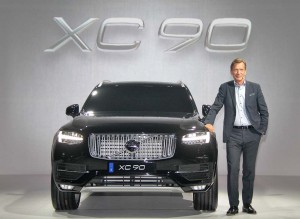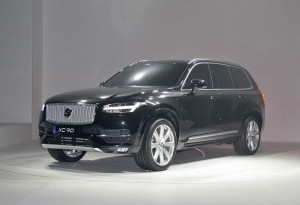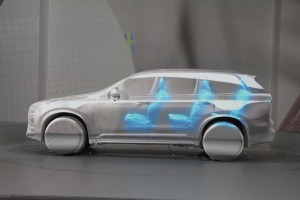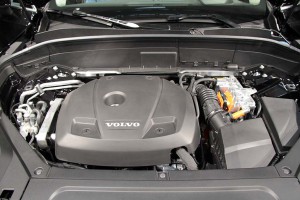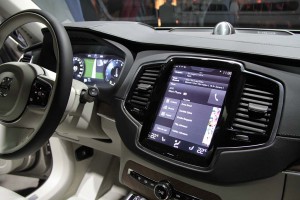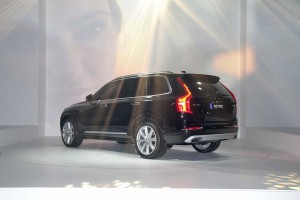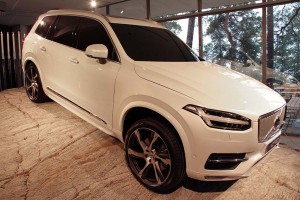With today’s unveiling of an all-new XC90, Volvo Cars is giving the world a good look at the many changes that will likely determine the future success of the Swedish automaker.
While echoing the basic shape of the old Volvo XC90, the new ute adopts new, and more luxurious proportions, as well as a more sophisticated interior. But many of the most significant changes aren’t as readily apparent. They include an all-new platform, or architecture, that will serve as the foundation of many future Volvo products.
The new ute, due to market next April, also gets a sophisticated, tablet-style touchscreen display to control everything from its infotainment system to its climate control. The 2016 Volvo XC90 also will see the maker introduce a wide arrange of new Drive-E powertrains, including Volvo’s new plug-in hybrid system designed to deliver both performance and fuel economy, depending on what mode it’s operating in.
“This is the first visible result of the transformation of Volvo Cars since 2010 when it was sold by Ford Motor Co.” to China’s Zhejiang Geely Holdings, proclaimed Hakan Samuelsson, the president and CEO of the Volvo Car Group.
The XC90 is the first new vehicle based on the scalable SPA architecture, a platform designed to eventually handle a wide range of utility vehicles, wagons and sedans, including the next versions of Volvo models like the V50 wagon and S60 sedan. Meanwhile, Volvo and Geely are separately collaborating on the development of another new architecture, dubbed CMA, which will be used for smaller models, including the next S40 sedan.
(Volvo earns top safety rating with latest auto-brake system. Click Here to see who else scored the IIHS award.)
In all, the maker, with the approval of its Chinese parent, plans to invest 75 billion Swedish kronor, or around $11 billion, through 2016, with heavy sending to continue through the rest of the decade, the CMA platform not due out until around 2019.
Volvo has hinted at where it would go with the new XC90 with a series of three recent concept vehicles, a coupe, sedan and, most recently, a crossover-utility show car. The production model isn’t quite as edgy, but still moves design a significant step forward from the current XC90, no surprise considering the outgoing ute has been on the market for 13 years, about twice the normal lifecycle for a luxury vehicle.
“The proportions are our entry point for playing in the (luxury) league,” said Thomas Ingenlath, Volvo’s chief designer. “The wrong proportions and you’d never be accepted,” he said, adding that an added advantage is the XC90 will have the most wind-slick aerodynamics in its segment.
The three-row, 7-passenger XC90 is distinguished by its long hood, wheels that push to the corners, and a large and airy greenhouse that is capped by a full-size panoramic glass roof. The ute introduces the new “face” of Volvo, added Ingenlath, a more pronounced version of the Volvo “Iron Mark” logo and grille, framed by new “Thor’s Hammer” headlamps.
The interior, meanwhile, puts still more of a premium on the simple yet elegant feel of Scandinavian design, with premium leather, wood, chrome and other materials. The plug-in hybrid model even gets a handmade Orefors cut crystal gearshift lever.
But the most eye-catching feature is likely to be the 12-inch vertical, or portrait-oriented touchscreen display, the industry’s largest with the exception of the screen in the Tesla Model S battery-car. Using a new HMI, or Human-Machine Interface, it’s designed to intuitively handle virtually all vehicle operations, from programming the navigation system to operating the built-in WiFi hotspot, as well as audio and climate control systems.
While Volvo officials acknowledge the rampant complaints about other touchscreen automotive systems, they insist the extra effort they’ve put into the Sensus interface – aided by its tablet size – should overcome such problems with the XC90.
“It was something we discussed heavily, aggressively,” acknowledged Ingenlath.
Traditionally known for its focus on safety, Volvo isn’t backing off with the XC90, and is launching a number of new technologies, including one that is designed to prevent a driver from inadvertently pulling in front of an oncoming vehicle when, say, turning left at a traffic light. There’s also a new auto parking system and on the highway, the 2016 XC90 will all but drive without driver steering intervention.
(Volvo one of the automakers betting death-free highways are now a real possibility. Click Here for the story.)
The XC90 brings with it a wide range of new powertrains Volvo has collectively dubbed Drive-E. The maker is migrating to a strategy relying only on four-cylinder engines, with an even smaller, three-cylinder powerplant under development.
There will be two gasoline engines, the T6 using both turbo and supercharger to produce 316 horsepower and the T5 which Volvo hasn’t yet rated. And there are two diesels, including the turbocharged 225 hp D5. All use an Aisin-produced 8-speed automatic.
Volvo is hoping to gain strong traction, meanwhile, for its new plug-in hybrid. It will pitch the new T8 as what CEO Samuelsson is calling the “Twin Engine.” It is, basically, a T6 gas engine paired with an 80-horsepower electric motor. The combination pumps out a hefty 400 horsepower and 443 pound-feet torque, competitive with some of the more powerful vehicles in the segment. It also uses the gas engine to drive the front axle, the electric motor the rear, creating what some have dubbed a “through-the-road” all-wheel-drive system.
The 2016 Volvo XC90 will reach showrooms next April, with the base price set at $48,990 plus a yet-undetermined destination fee. The plug-in will come out about a year later. Volvo also will offer a Special Edition model, with only 1927 produced – to celebrate the year of the company’s founding. At $65,900, it will be loaded with all available options. Volvo will begin taking orders for the Special Edition on August 28th, and only online.
(Volvo may soon begin importing cars from China. Click Here for the story.)
The Swedish maker is hoping to sell about 50,000 XC90s during the model’s first year, with volume climbing to 80,000 annually beyond that. It expects the U.S. to be the ute’s largest market, accounting for around a third of total worldwide sales.
Equally important, Volvo is betting that the XC90 will be able to reinvigorate its presence in the global luxury market. The maker has been struggling in recent years, 2013 sales totaling just 428,000, down 30,000 units from the brand’s 2007 peak. But with the addition of the XC90 and other models to come, Volvo and its Chinese parent are optimistically planning for a bright future, with sales aimed to reach 800,000 by decade’s end.

